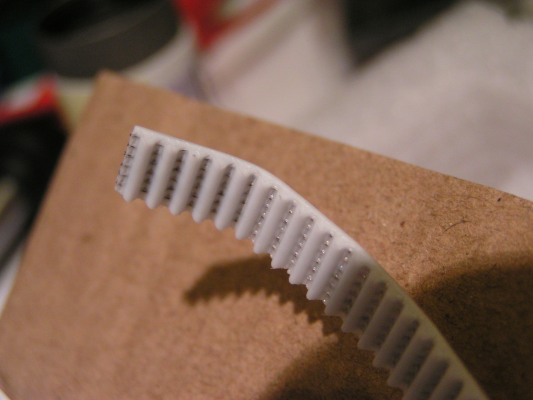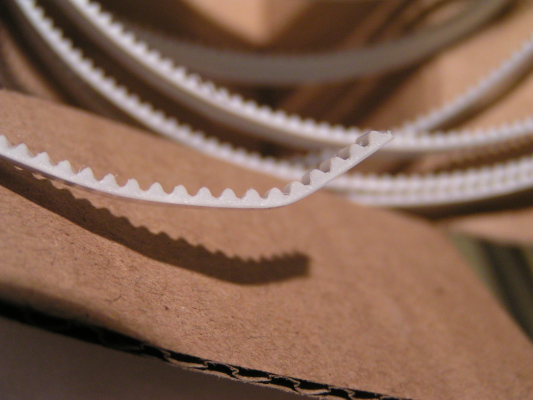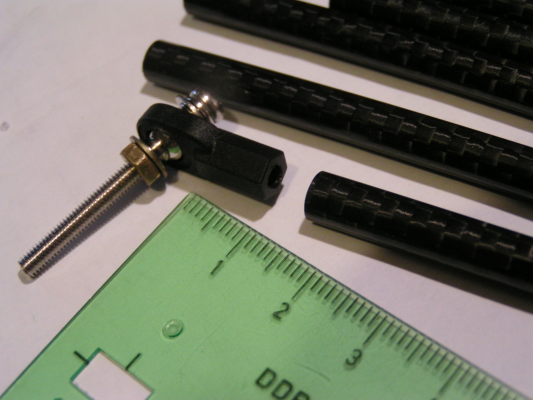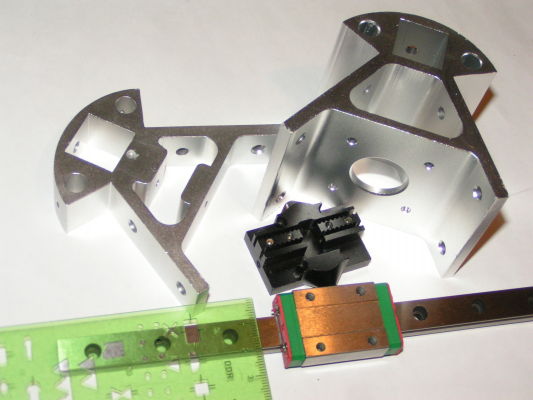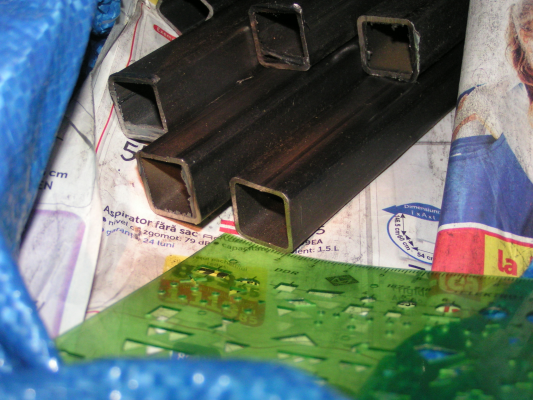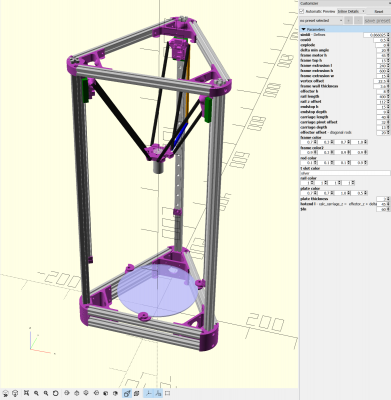Beginner's questions about a custom delta design
Posted by RoGeorge
|
Beginner's questions about a custom delta design March 21, 2018 04:20PM |
Registered: 6 years ago Posts: 10 |
I am tinkerer at heart and building my first delta, but have no previous experience in 3D printing, so I'm open to any comments and suggestions.
It will be a custom design based on 70 cm long linear rails (already have the 3 rails), which will impose a total height of about 1 meter (3 feet).
First question is about the belt, please. It has 2 mm teeth (GT2 like, no-name from AliExpress, 10 meters of belt for $8.25 and free shipping) with metal wires reinforcement. My concern is that the reinforcing wires will come in touch with the Aluminum pulleys and damage their teeth.
Is it normal for the reinforcing wires to be visible between the belt's teeth?
Wouldn't those wires damage the pulleys?
[hackaday.io]
[rogeorge.wordpress.com]
It will be a custom design based on 70 cm long linear rails (already have the 3 rails), which will impose a total height of about 1 meter (3 feet).
First question is about the belt, please. It has 2 mm teeth (GT2 like, no-name from AliExpress, 10 meters of belt for $8.25 and free shipping) with metal wires reinforcement. My concern is that the reinforcing wires will come in touch with the Aluminum pulleys and damage their teeth.
Is it normal for the reinforcing wires to be visible between the belt's teeth?
Wouldn't those wires damage the pulleys?
[hackaday.io]
[rogeorge.wordpress.com]
|
Re: Beginner's questions about a custom delta design March 21, 2018 04:39PM |
Registered: 10 years ago Posts: 14,672 |
Steel core belts will fracture if you used them with the small (16 or 20 tooth) pulleys that you need on a delta to get a high enough steps/mm. Use glass reinforced belts instead.
More suggestions at [miscsolutions.wordpress.com].
Edited 1 time(s). Last edit at 03/21/2018 04:40PM by dc42.
Large delta printer [miscsolutions.wordpress.com], E3D tool changer, Robotdigg SCARA printer, Crane Quad and Ormerod
Disclosure: I design Duet electronics and work on RepRapFirmware, [duet3d.com].
More suggestions at [miscsolutions.wordpress.com].
Edited 1 time(s). Last edit at 03/21/2018 04:40PM by dc42.
Large delta printer [miscsolutions.wordpress.com], E3D tool changer, Robotdigg SCARA printer, Crane Quad and Ormerod
Disclosure: I design Duet electronics and work on RepRapFirmware, [duet3d.com].
|
Re: Beginner's questions about a custom delta design March 21, 2018 06:02PM |
Registered: 6 years ago Posts: 10 |
Quote
dc42
Steel core belts will fracture if you used them with the small (16 or 20 tooth) pulleys
Outch! Didn't know that, thank you.
Indeed, now I see the steel reinforced belt isn't very flexible when compared to a fiber glass reinforced one (I also have another 10 meters of GT2.5 fiber glass reinforced belt and 5 of 2.5mm/16 teeth pulleys).
Since a new order will take another 2 months to arrive, and since the printer is far from being ready, do you think it will make sense to test the current belt with just one motor and 16 teeth pulley?
If the test will be just a continuously back and forth, after how many times of belt bending might appear some visible fracture?
I am asking if a test rig will make sense because the belt was advertised as being for 3D printers (and mostly because my inner wish is that maybe this particular belt won't fracture).
[www.aliexpress.com]
Edited 3 time(s). Last edit at 03/21/2018 06:12PM by RoGeorge.
[hackaday.io]
[rogeorge.wordpress.com]
|
Re: Beginner's questions about a custom delta design March 21, 2018 06:07PM |
Registered: 10 years ago Posts: 14,672 |
It will probably take some time for the belt to fracture, so I suggest you order new belts but use the steel core ones meanwhile.
Large delta printer [miscsolutions.wordpress.com], E3D tool changer, Robotdigg SCARA printer, Crane Quad and Ormerod
Disclosure: I design Duet electronics and work on RepRapFirmware, [duet3d.com].
Large delta printer [miscsolutions.wordpress.com], E3D tool changer, Robotdigg SCARA printer, Crane Quad and Ormerod
Disclosure: I design Duet electronics and work on RepRapFirmware, [duet3d.com].
|
Re: Beginner's questions about a custom delta design March 21, 2018 06:12PM |
Registered: 6 years ago Posts: 10 |
Another option for me will be to use the fiber glass GT2.5 belt with 16 teeth 2.5mm pulleys for the motors, and flip the belt on the other side, so I could use the 2 mm teeth free will pulleys.
Is it OK to twist once all the belts in a delta, so at the motor end the 2.5mm teeth will match, and at the other end the smooth side of the belt to roll over the 2 mm teeth?
[hackaday.io]
[rogeorge.wordpress.com]
Is it OK to twist once all the belts in a delta, so at the motor end the 2.5mm teeth will match, and at the other end the smooth side of the belt to roll over the 2 mm teeth?
[hackaday.io]
[rogeorge.wordpress.com]
|
Re: Beginner's questions about a custom delta design March 22, 2018 03:28AM |
Registered: 10 years ago Posts: 14,672 |
Is it that hard to buy glass core GT2 belts in your country?
You can put a twist in the idle run of the belt between the two pulleys.
Large delta printer [miscsolutions.wordpress.com], E3D tool changer, Robotdigg SCARA printer, Crane Quad and Ormerod
Disclosure: I design Duet electronics and work on RepRapFirmware, [duet3d.com].
You can put a twist in the idle run of the belt between the two pulleys.
Large delta printer [miscsolutions.wordpress.com], E3D tool changer, Robotdigg SCARA printer, Crane Quad and Ormerod
Disclosure: I design Duet electronics and work on RepRapFirmware, [duet3d.com].
|
Re: Beginner's questions about a custom delta design March 22, 2018 04:51AM |
Registered: 6 years ago Posts: 10 |
I will follow your advice, and use the steel reinforced belt until a new glass core belt will arrive, thank you.
GT2 belt can be found even locally but a few times more expensive than on AliExpress, just that I like to build with whatever I already have. I guess this is a bad habit of mine, from the period when parts where not available here, in Romania. Also, some parts were bought about 2 years ago and the project stalled since then, which tells me that I don't really need a 3D printer. It's more the curiosity to experiment than the need for a printer, so no hurry to finish it.
By the way, one of the goals with this printer will be to have an interchangeable head, so the printer can be turned into a pick and place machine for populating electronic boards with electronic components. It will be a long way to do that, if will ever work at all. For the first step it will have just a 3D printing head, in order to understand the possible pitfalls for turning it into a pick and place machine.
The next question is about the rods.
I already have 6 carbon fiber rods. 30cm long, 6mm external diameter, 4mm internal diameter, 7 grams and $5 each. $5 for a 30cm stick seems expensive, so I would like to use them. Yet I would like to have a printing radius bigger than what a 30cm rod will allow.
I am not sure why I want some extra printing area, but I think it doesn't hurt to have that available, or does it?
Does it makes any sense to extend the rods by gluing some 4 mm metal studs at the ends of the carbon fiber rods? Or it is better to let the rods as they are, and be happy with the printing radius given by a 30cm rod?
[hackaday.io]
[rogeorge.wordpress.com]
GT2 belt can be found even locally but a few times more expensive than on AliExpress, just that I like to build with whatever I already have. I guess this is a bad habit of mine, from the period when parts where not available here, in Romania. Also, some parts were bought about 2 years ago and the project stalled since then, which tells me that I don't really need a 3D printer. It's more the curiosity to experiment than the need for a printer, so no hurry to finish it.

By the way, one of the goals with this printer will be to have an interchangeable head, so the printer can be turned into a pick and place machine for populating electronic boards with electronic components. It will be a long way to do that, if will ever work at all. For the first step it will have just a 3D printing head, in order to understand the possible pitfalls for turning it into a pick and place machine.
The next question is about the rods.
I already have 6 carbon fiber rods. 30cm long, 6mm external diameter, 4mm internal diameter, 7 grams and $5 each. $5 for a 30cm stick seems expensive, so I would like to use them. Yet I would like to have a printing radius bigger than what a 30cm rod will allow.
I am not sure why I want some extra printing area, but I think it doesn't hurt to have that available, or does it?
Does it makes any sense to extend the rods by gluing some 4 mm metal studs at the ends of the carbon fiber rods? Or it is better to let the rods as they are, and be happy with the printing radius given by a 30cm rod?
[hackaday.io]
[rogeorge.wordpress.com]
|
Re: Beginner's questions about a custom delta design March 22, 2018 06:04AM |
Registered: 10 years ago Posts: 14,672 |
I suggest you choose a smaller printing radius, to avoid adding too much extra mass to the rods. It looks like you are using Traxxas rod ends, so the overall rod length between bearing centres will be around 330mm. With that length, I think you should be able to achieve a 270mm print diameter if you design the rest of the machine carefully.
Large delta printer [miscsolutions.wordpress.com], E3D tool changer, Robotdigg SCARA printer, Crane Quad and Ormerod
Disclosure: I design Duet electronics and work on RepRapFirmware, [duet3d.com].
Large delta printer [miscsolutions.wordpress.com], E3D tool changer, Robotdigg SCARA printer, Crane Quad and Ormerod
Disclosure: I design Duet electronics and work on RepRapFirmware, [duet3d.com].
|
Re: Beginner's questions about a custom delta design March 22, 2018 09:03AM |
Registered: 10 years ago Posts: 732 |
You need to consider a steel core belt like a consumable but if you want to print quickly you may prefer steel to glass:
See: [forums.reprap.org]
See: [forums.reprap.org]
|
Re: Beginner's questions about a custom delta design March 24, 2018 07:26AM |
Registered: 6 years ago Posts: 10 |
OK then, smaller radius with lighter rods, and steel core belt will be, thank you! 
The ball-joints are Traxxas-like, cheap and no-name. They have some backlash. I don't know if that amount of backlash is normal, or if it is because of the low quality of the ball-joints. The backlash is very big, and clearly visible on the direction perpendicular to the rod. On the longitudinal direction (relative to the rod), the backlash can only be felt at hand, but it is almost invisible to the eye. There will be two springs for each pair of rods, one spring near each rods' ends, so that the perpendicular backlash will not appear during printing.
Anyway, the backlash seems pretty big to me. In the hope that any plastic deformation happened during the ball assembly will revert to the original dimensions, I already boiled the joints, and applied thermal shocks by repeatedly diving the ball-joints into hot and cold water, but with no visible reduction of the backlash. Please see the end result:
[www.youtube.com]
Are these ball-joints usable, or the backlash is too big?
[hackaday.io]
[rogeorge.wordpress.com]

The ball-joints are Traxxas-like, cheap and no-name. They have some backlash. I don't know if that amount of backlash is normal, or if it is because of the low quality of the ball-joints. The backlash is very big, and clearly visible on the direction perpendicular to the rod. On the longitudinal direction (relative to the rod), the backlash can only be felt at hand, but it is almost invisible to the eye. There will be two springs for each pair of rods, one spring near each rods' ends, so that the perpendicular backlash will not appear during printing.
Anyway, the backlash seems pretty big to me. In the hope that any plastic deformation happened during the ball assembly will revert to the original dimensions, I already boiled the joints, and applied thermal shocks by repeatedly diving the ball-joints into hot and cold water, but with no visible reduction of the backlash. Please see the end result:
[www.youtube.com]
Are these ball-joints usable, or the backlash is too big?
[hackaday.io]
[rogeorge.wordpress.com]
|
Re: Beginner's questions about a custom delta design March 24, 2018 05:15PM |
Registered: 10 years ago Posts: 732 |
The ball joints in the video SUCK BIG TIME!!!
I'm no fan of magnetic joints (they are too heavy and weak) but compared to the ball joint in the video I would rather take magnetic joints which suck a bit less :-D
Get ball joints which are sold already assembled and which are tight. If there is some local shop for RC model planes or even better RC model helicopters then get the ball joints in the shop. They can show them to you and you can select the ones which are actually good. My guess is that the ball joints are better and better in this order:
If you cannot try to the joints in advance and want to be sure just buy some for a big RC helicopter rotor control rods.
I'm no fan of magnetic joints (they are too heavy and weak) but compared to the ball joint in the video I would rather take magnetic joints which suck a bit less :-D
Get ball joints which are sold already assembled and which are tight. If there is some local shop for RC model planes or even better RC model helicopters then get the ball joints in the shop. They can show them to you and you can select the ones which are actually good. My guess is that the ball joints are better and better in this order:
- ball joints for RC cars; these sometimes suck, like e.g. the traxxas crap
- ball joints for RC planes; these are better
- ball joints for RC helicopters especially those designed for the main rotor control rods (from upper swash plate to rotor blades); these are best
If you cannot try to the joints in advance and want to be sure just buy some for a big RC helicopter rotor control rods.
|
Re: Beginner's questions about a custom delta design March 25, 2018 03:34AM |
Registered: 6 years ago Posts: 10 |
Quote
hercek
The ball joints in the video SUCK BIG TIME!!!
That^ is what I was afraid of.

I guess the crappy ball-joints in the video are exactly what one will get for $0.83/piece instead of $5.00/piece. Thank you for explaining were from to source better ones.
For the next version I will probably go with magnetic ball joints, mainly because I need to switch heads easily.
[hackaday.io]
[rogeorge.wordpress.com]
|
Re: Beginner's questions about a custom delta design March 25, 2018 09:57AM |
Registered: 10 years ago Posts: 732 |
Well, there are 6 pieces in the $5 pack. That makes it $10 per one 3d printer. Plus shipping. Not too bad.
If you are in US, I bet you can find some US based ball joints which have good quality.
If it is only about replacing the print head then magnetic joints do not make much difference. My head is screwed to the platform (to which the ball joints are screwed). It is not a problem to replace the head - only two M4 screws. Well, there is also a bowden and 2 connectors, but you have this with magnetic joints too. Replacing a platform would be significant work compared to magnetic joints but I did this only when replacing the diagonal rods. I did that 4 times in maybe 4 years? That was to get more precise or longer rods. I do not expect to ever replace the last rod set. Those are pretty solid.
But if you want to replace the platform often and do not need to print quickly under high accelerations then magnetic joints are a good choice. And if you intend to print slowly then you can also swap your steel based belts with some glass based belts too. The glass based belts will last "forever". My very rough estimate for steel core belts (T2.5 with 16 tooth pulley) is: one of the 3 belts needs to be replaced after printing about 20 kg of material. A very rough estimate because my sample size is way too small.
If you are in US, I bet you can find some US based ball joints which have good quality.
If it is only about replacing the print head then magnetic joints do not make much difference. My head is screwed to the platform (to which the ball joints are screwed). It is not a problem to replace the head - only two M4 screws. Well, there is also a bowden and 2 connectors, but you have this with magnetic joints too. Replacing a platform would be significant work compared to magnetic joints but I did this only when replacing the diagonal rods. I did that 4 times in maybe 4 years? That was to get more precise or longer rods. I do not expect to ever replace the last rod set. Those are pretty solid.
But if you want to replace the platform often and do not need to print quickly under high accelerations then magnetic joints are a good choice. And if you intend to print slowly then you can also swap your steel based belts with some glass based belts too. The glass based belts will last "forever". My very rough estimate for steel core belts (T2.5 with 16 tooth pulley) is: one of the 3 belts needs to be replaced after printing about 20 kg of material. A very rough estimate because my sample size is way too small.
|
Re: Beginner's questions about a custom delta design March 25, 2018 10:10AM |
Registered: 10 years ago Posts: 732 |
Some people prefer magnetic joints because they disconnect when the print head hits something. I doubt it is an advantage. My printer just skips steps when the print head hits something. If I'm nearby I stop the print. Otherwise it would continue badly. Waste of filament but not a big deal. It happened to me a few times when a corner of a printed ABS part pealed off.
At least I do not need to reconnect the diagonal rods
Is it a good idea if your hotend at about 200 °C drops into a failed print and continues heating there? Well that is not such a bad thing. It could be worse if it would drop next to the printer and near your acetone bottle. That could be a serious problem. Not that it is a good idea to have something highly flammable near to a working 3d printer.
At least I do not need to reconnect the diagonal rods

Is it a good idea if your hotend at about 200 °C drops into a failed print and continues heating there? Well that is not such a bad thing. It could be worse if it would drop next to the printer and near your acetone bottle. That could be a serious problem. Not that it is a good idea to have something highly flammable near to a working 3d printer.
|
Re: Beginner's questions about a custom delta design March 25, 2018 12:29PM |
Registered: 6 years ago Posts: 15 |
I just ordered some from here [www.aircraft-world.com]. Mainly because shipping was just $2.20 from Japan to UK. It was the cheapest I could find the MP Jet balls including shipping.
$10.53 for 14 joints including shipping.
$10.53 for 14 joints including shipping.
|
Re: Beginner's questions about a custom delta design March 25, 2018 12:50PM |
Registered: 6 years ago Posts: 10 |
My bad, I didn't noticed the RC ball joints price is for a pack of 6. That will make the MP-JET ones to be basically the same price as my $10 for 12 lousy AliExpress ball joints. 
I am in Bucharest, Romania, EU. There must be some RC brick and mortar shops around, I will look for them next week.
In my case, the reason for changing the heads, and so considering the magnetic joints, is because I will like to adapt a vacuum needle instead of the usual extruder. The vacuum needle is suppose to pick very small (millimeter size) electronic components and place them on an electronic board, because manually pick and place SMD parts is very tedious.
Since I have no previous experience in 3D printing or any other kind of CNC machines, I will start by building a delta printer, mainly to learn what could go wrong. From there, the next step will be to transform the delta printer into a pick and place machine for electronics. If that will fail, at least I will have a 3D printer instead of just a box of sloppy parts, as I have now. Since I am not planning to turn this into a commercial product, I guess the speed is not critical, and also I would like to use as much as possible the parts that I already have.
Since I am not planning to turn this into a commercial product, I guess the speed is not critical, and also I would like to use as much as possible the parts that I already have.
Indeed some of the parts, if not most of them, are almost unusable, but as a first step I will be happy if at least it moves and print something, no matter how bad or slow that first print will be.
[hackaday.io]
[rogeorge.wordpress.com]

I am in Bucharest, Romania, EU. There must be some RC brick and mortar shops around, I will look for them next week.
In my case, the reason for changing the heads, and so considering the magnetic joints, is because I will like to adapt a vacuum needle instead of the usual extruder. The vacuum needle is suppose to pick very small (millimeter size) electronic components and place them on an electronic board, because manually pick and place SMD parts is very tedious.
Since I have no previous experience in 3D printing or any other kind of CNC machines, I will start by building a delta printer, mainly to learn what could go wrong. From there, the next step will be to transform the delta printer into a pick and place machine for electronics. If that will fail, at least I will have a 3D printer instead of just a box of sloppy parts, as I have now.
 Since I am not planning to turn this into a commercial product, I guess the speed is not critical, and also I would like to use as much as possible the parts that I already have.
Since I am not planning to turn this into a commercial product, I guess the speed is not critical, and also I would like to use as much as possible the parts that I already have.Indeed some of the parts, if not most of them, are almost unusable, but as a first step I will be happy if at least it moves and print something, no matter how bad or slow that first print will be.
[hackaday.io]
[rogeorge.wordpress.com]
|
Re: Beginner's questions about a custom delta design March 25, 2018 05:53PM |
Registered: 6 years ago Posts: 10 |
Order and wait, or improvise?
I don't have the 20x20 mm Aluminium profiles for the frame yet. This was difficult to source at a reasonable price and at a custom length. I finally found a local provider, but it will take a couple of days, and is quite expensive. Does it makes sense to improvise with the frame?
First, I have some linear rails that seems pretty solid. Does those really need to be screwed on some pillars? Wouldn't be enough to use the linear rails as vertical pillars too? The linear rails are MGN12, as in the pic.
Second, it happens that I already have 6 meters of 2 cm square steel pipe with 1.6mm thick walls. They are very heavy compared with the 20x20 Aluminium profiles, and I would need to drill quite a lot of holes. The linear rails have a hole at each inch, do the linear rails really need a screw at each 2.54cm?
Or, just order Aluminium 20x20 profiles and wait?
[hackaday.io]
[rogeorge.wordpress.com]
I don't have the 20x20 mm Aluminium profiles for the frame yet. This was difficult to source at a reasonable price and at a custom length. I finally found a local provider, but it will take a couple of days, and is quite expensive. Does it makes sense to improvise with the frame?
First, I have some linear rails that seems pretty solid. Does those really need to be screwed on some pillars? Wouldn't be enough to use the linear rails as vertical pillars too? The linear rails are MGN12, as in the pic.
Second, it happens that I already have 6 meters of 2 cm square steel pipe with 1.6mm thick walls. They are very heavy compared with the 20x20 Aluminium profiles, and I would need to drill quite a lot of holes. The linear rails have a hole at each inch, do the linear rails really need a screw at each 2.54cm?
Or, just order Aluminium 20x20 profiles and wait?
[hackaday.io]
[rogeorge.wordpress.com]
|
Re: Beginner's questions about a custom delta design March 26, 2018 12:45AM |
Registered: 7 years ago Posts: 18 |
|
Re: Beginner's questions about a custom delta design March 26, 2018 04:59AM |
Registered: 8 years ago Posts: 5,232 |
|
Re: Beginner's questions about a custom delta design March 27, 2018 03:02PM |
Registered: 6 years ago Posts: 10 |
TL;DR How to get the cutting length of the profiles for the printer base, taking into account the maximum allowed angle in the ball joints?
In the last couple of days I was trying to understand what are the main limitations that dictates the size of a delta printer, in general. Let's consider first the mechanical limitations for dimensions only, without considering forces and speeds, and for a delta printer where everything is symmetric to the vertical central axis.
One more mention: this printer is based on a Kossel design (it has linear rails - not sure what key features gives the name for a delta design).
1. The most obvious limitation will be the diagonal rod's length.
2. Next one will be the linear rail's height.
These two limitation are very straightforward. Shorter rods will limit the maximum printing radius, shorter linear rails will limit the maximum printing height.
3. The next limitation is not so obvious, and is given by the ball joint's maximum allowed angle. For me, it was a surprise how small this angle is, about 45* (or +/- 22.5 degrees around the normal position) for a Traxxas like ball-joint. Some metal only ball joints have even smaller angle, like +/-15* only.
Now, let's make a rough approximation. If the rod is 330mm and the maximum angle is 45*, this will give an isosceles triangle where the 3rd side is 253mm. Then, no matter what, the most far away points that can be reached by the printing nozzle must be somewhere between a circle of 253mm diameter.
Are there any size calculators, or simulators, where I can set the maximum allowed angle of the ball joints?
If not, I am thinking of modifying this OpenSCAD Kossel model (Jaydmdigital's mk_visual_calc), so it can take the main limitation from points 1...3 together with the effector size as input parameters, and calculate the dimensions of frame or the 20x20 cutting lengths as output.
By the way, this is my first encounter with OpenSCAD and I love it. So elegant and simple to use, yet so powerful!
[hackaday.io]
[rogeorge.wordpress.com]
In the last couple of days I was trying to understand what are the main limitations that dictates the size of a delta printer, in general. Let's consider first the mechanical limitations for dimensions only, without considering forces and speeds, and for a delta printer where everything is symmetric to the vertical central axis.
One more mention: this printer is based on a Kossel design (it has linear rails - not sure what key features gives the name for a delta design).
1. The most obvious limitation will be the diagonal rod's length.
2. Next one will be the linear rail's height.
These two limitation are very straightforward. Shorter rods will limit the maximum printing radius, shorter linear rails will limit the maximum printing height.
3. The next limitation is not so obvious, and is given by the ball joint's maximum allowed angle. For me, it was a surprise how small this angle is, about 45* (or +/- 22.5 degrees around the normal position) for a Traxxas like ball-joint. Some metal only ball joints have even smaller angle, like +/-15* only.
Now, let's make a rough approximation. If the rod is 330mm and the maximum angle is 45*, this will give an isosceles triangle where the 3rd side is 253mm. Then, no matter what, the most far away points that can be reached by the printing nozzle must be somewhere between a circle of 253mm diameter.
How can it be achieved a diameter of 270mm, when there seems to be a limitation for a maximum 253mm? Just to be clear, I am not trying to be nitpicking or pedantic here. All I want is to understand how to calculate the limits, and I am asking this to be sure that I am not missing something.Quote
dc42
I suggest you choose a smaller printing radius, to avoid adding too much extra mass to the rods. It looks like you are using Traxxas rod ends, so the overall rod length between bearing centres will be around 330mm. With that length, I think you should be able to achieve a 270mm print diameter if you design the rest of the machine carefully.
Are there any size calculators, or simulators, where I can set the maximum allowed angle of the ball joints?
If not, I am thinking of modifying this OpenSCAD Kossel model (Jaydmdigital's mk_visual_calc), so it can take the main limitation from points 1...3 together with the effector size as input parameters, and calculate the dimensions of frame or the 20x20 cutting lengths as output.
By the way, this is my first encounter with OpenSCAD and I love it. So elegant and simple to use, yet so powerful!
[hackaday.io]
[rogeorge.wordpress.com]
|
Re: Beginner's questions about a custom delta design March 27, 2018 07:09PM |
Registered: 10 years ago Posts: 14,672 |
Quote
RoGeorge
3. The next limitation is not so obvious, and is given by the ball joint's maximum allowed angle. For me, it was a surprise how small this angle is, about 45* (or +/- 22.5 degrees around the normal position) for a Traxxas like ball-joint. Some metal only ball joints have even smaller angle, like +/-15* only.
Now, let's make a rough approximation. If the rod is 330mm and the maximum angle is 45*, this will give an isosceles triangle where the 3rd side is 253mm. Then, no matter what, the most far away points that can be reached by the printing nozzle must be somewhere between a circle of 253mm diameter.
Not so. Traxxas and similar joints are only limited in two planes. They do 360 degrees in the third plane. So reaching the edge of the bed opposite a tower is easy; it's the sideway movement of the effector relative to a tower that might reach the joint movement limit.
Also, I'm sure the range of Traxxas joints in the other 2 planes is way more than 45 degrees, closer to 90 degrees AFAIR.
Edited 1 time(s). Last edit at 03/27/2018 07:12PM by dc42.
Large delta printer [miscsolutions.wordpress.com], E3D tool changer, Robotdigg SCARA printer, Crane Quad and Ormerod
Disclosure: I design Duet electronics and work on RepRapFirmware, [duet3d.com].
Sorry, only registered users may post in this forum.

